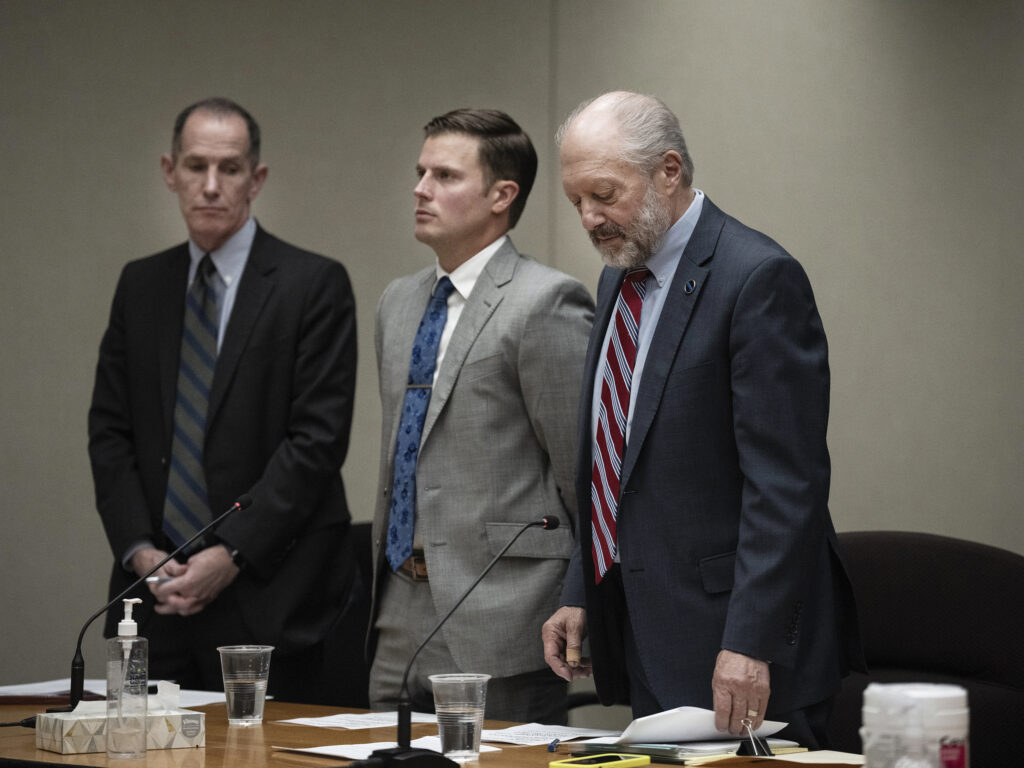Attorneys Chris Madel, left, and Fred Bruno, right, stand by the side of former Minneapolis police officer Justin Stetson, who was sentenced for beating Jaleel Stallings amid the civil unrest after George Floyd’s murder, at the Hennepin County Government Center in Minneapolis, on Monday, Oct. 23, 2023. Photo by Richard Tsong-Taatarii/Star Tribune via AP.
An important footnote to the police murder of George Floyd was the infamous press release the Minneapolis Police Department sent out after Floyd’s death.
The headline: “Man dies after medical incident during police interaction.”
The description was equally brazen in what it left out: “Officers were able to get the suspect into handcuffs and noted he appeared to be suffering medical distress. Officers called for an ambulance. He was transported to Hennepin County Medical Center by ambulance where he died a short time later.”
In reality, as Dr. Martin Tobin testified at Derek Chauvin’s trial, Floyd suffocated because he was face down on the pavement and handcuffed while Chauvin’s left knee was putting pressure on the neck area.
We’ve come to expect a casual relationship to the truth when it comes to MPD, which erodes trust in the department and sends a message to officers that it’s fine to lie, be it to the public, command staff or on the witness stand.
One would hope reform-minded Chief Brian O’Hara, who came aboard in late 2022, is putting a stop to it, but an MPD spokesman recently made a provably untrue statement in the pages of the Washington Post.
The Post recently profiled Jaleel Stallings. His story was exhaustively covered first by the Reformer’s Deena Winter, beginning with his acquittal in 2021 on charges he sought to kill police officers. A jury found he acted in self-defense.
The prosecution also collapsed because body-camera footage contradicted what officers claimed in their reports.
Former Hennepin County Attorney Mike Freeman — hardly an anti-police prosecutor — later said officers lied to prosecutors, which contributed to the miscarriage of justice.
Here’s MPD’s response in the Post: “In an email, police spokesperson Sgt. Garrett Parten denied that officers had lied.”
Let’s just start here: Stallings was acquitted, an MPD officer wound up pleading guilty to assault, and the city had to pay Stallings $1.5 million for his ordeal.
The cat is totally out of the bag, but MPD is still claiming officers didn’t lie about what went on that night. (I emailed Parten to ask about his statement, but he wasn’t available.)
Where to begin?
Sgt. Andrew Bittell and Officer Justin Stetson, who would later plead guilty to felony assault, testified — in court! — that their use of force was necessary because Stallings was resisting arrest.
In fact, as Winter reported, bodycam footage showed Stallings dropped his gun on the ground and lay face down, with his hands to the side above his head, surrendering. He didn’t move for 20 seconds as the officers approached.
“You f***ing piece of shit!” Stetson yelled, and began kicking and punching Stallings in the head and neck. Stallings didn’t move. He was trying to surrender and de-escalate the situation, he told Winter in an interview. Bittell began kneeing and punching Stallings in the stomach, chest and back.
After handcuffing him, Bittell sat Stallings up and kicked him in the ribs as Stetson continued hitting him in the head.
The charging documents against Stetson said Stallings “had already surrendered, was lying prone on the ground, posed no imminent threat and did not resist Stetson’s use of force.”
By pleading guilty, Stetson conceded that Stallings wasn’t resisting, i.e., he had lied.
But MPD is claiming Stetson didn’t lie, which means the “blue wall of silence” extends even to disgraced officers who have confessed in court.
Stetson and Bittell also claimed the use of force was necessary because they feared Stallings was armed, even though Stallings had dropped his gun and they didn’t search him for weapons.
(Interesting footnote: Both and Bittell and Stetson receive a disability pension despite Stetson’s guilty plea.)
Stallings was hospitalized with a fractured eye socket, even though the county attorney claimed in a press release after the incident that there were “no injuries.” (Wonder where he got that idea?)
The charging documents against Stallings said officers “deployed one 40-mm round at Stallings.” Not true. They fired two rounds before Stallings — an Army veteran who feared he’d been hit by white supremacists firing live ammunition — returned fire with his (permitted) pistol.
When Bittell asked his unit, “Did anybody shoot?” nobody mentioned that they’d shot Stallings with 40mm “less lethal” plastic projectiles before he fired back.
Not lying exactly, because they had not used their real guns, but definitely not entirely truthful, either.
You could reasonably argue that the officers were dealing with a chaotic scene during a challenging time, with Lake Street buildings still smoldering in the aftermath of the rioting.
The problem is that Minneapolis police went looking for trouble that night.
As Winter wrote in her first story: “Before the white, unmarked cargo van drove down Lake Street, an officer gave Bittell his orders: ‘Drive down Lake Street. You see a group, call it out. OK great! F*** ’em up, gas ’em, f*** ’em up.’”
This entire mission — if you wanna call it that — was based on a lie, that somehow what Minneapolis needed was an unmarked van of exhausted, ill-trained police officers shooting at people with 40mm rounds for breaking curfew.
The first step is admitting you have a problem, and MPD’s bizarre claim of honesty vis-a-vis the Stallings debacle does not inspire hope.
The post MPD still claiming officers were truthful in Jaleel Stallings case. They weren’t. appeared first on Minnesota Reformer.

